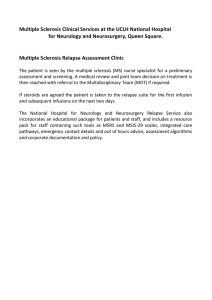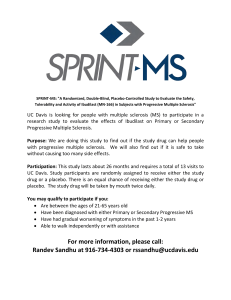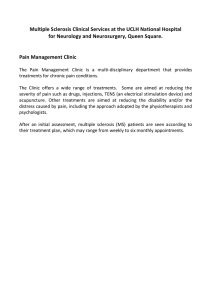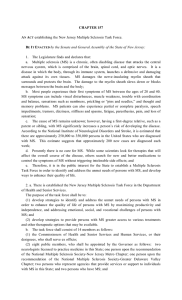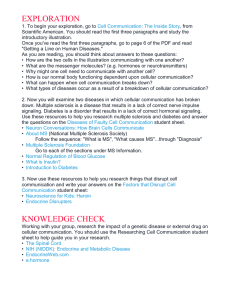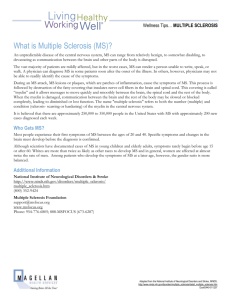Excess Mortality in Patients with Multiple Sclerosis Starts at 20 Years
advertisement
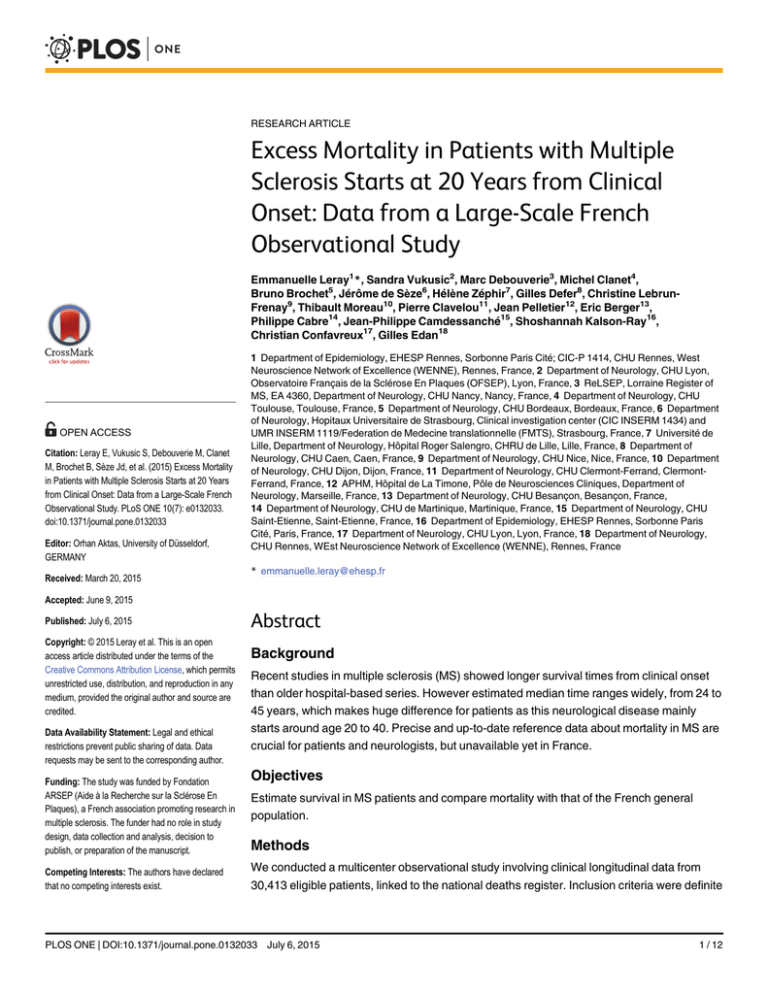
RESEARCH ARTICLE Excess Mortality in Patients with Multiple Sclerosis Starts at 20 Years from Clinical Onset: Data from a Large-Scale French Observational Study a11111 OPEN ACCESS Citation: Leray E, Vukusic S, Debouverie M, Clanet M, Brochet B, Sèze Jd, et al. (2015) Excess Mortality in Patients with Multiple Sclerosis Starts at 20 Years from Clinical Onset: Data from a Large-Scale French Observational Study. PLoS ONE 10(7): e0132033. doi:10.1371/journal.pone.0132033 Editor: Orhan Aktas, University of Düsseldorf, GERMANY Received: March 20, 2015 Emmanuelle Leray1*, Sandra Vukusic2, Marc Debouverie3, Michel Clanet4, Bruno Brochet5, Jérôme de Sèze6, Hélène Zéphir7, Gilles Defer8, Christine LebrunFrenay9, Thibault Moreau10, Pierre Clavelou11, Jean Pelletier12, Eric Berger13, Philippe Cabre14, Jean-Philippe Camdessanché15, Shoshannah Kalson-Ray16, Christian Confavreux17, Gilles Edan18 1 Department of Epidemiology, EHESP Rennes, Sorbonne Paris Cité; CIC-P 1414, CHU Rennes, West Neuroscience Network of Excellence (WENNE), Rennes, France, 2 Department of Neurology, CHU Lyon, Observatoire Français de la Sclérose En Plaques (OFSEP), Lyon, France, 3 ReLSEP, Lorraine Register of MS, EA 4360, Department of Neurology, CHU Nancy, Nancy, France, 4 Department of Neurology, CHU Toulouse, Toulouse, France, 5 Department of Neurology, CHU Bordeaux, Bordeaux, France, 6 Department of Neurology, Hopitaux Universitaire de Strasbourg, Clinical investigation center (CIC INSERM 1434) and UMR INSERM 1119/Federation de Medecine translationnelle (FMTS), Strasbourg, France, 7 Université de Lille, Department of Neurology, Hôpital Roger Salengro, CHRU de Lille, Lille, France, 8 Department of Neurology, CHU Caen, Caen, France, 9 Department of Neurology, CHU Nice, Nice, France, 10 Department of Neurology, CHU Dijon, Dijon, France, 11 Department of Neurology, CHU Clermont-Ferrand, ClermontFerrand, France, 12 APHM, Hôpital de La Timone, Pôle de Neurosciences Cliniques, Department of Neurology, Marseille, France, 13 Department of Neurology, CHU Besançon, Besançon, France, 14 Department of Neurology, CHU de Martinique, Martinique, France, 15 Department of Neurology, CHU Saint-Etienne, Saint-Etienne, France, 16 Department of Epidemiology, EHESP Rennes, Sorbonne Paris Cité, Paris, France, 17 Department of Neurology, CHU Lyon, Lyon, France, 18 Department of Neurology, CHU Rennes, WEst Neuroscience Network of Excellence (WENNE), Rennes, France * emmanuelle.leray@ehesp.fr Accepted: June 9, 2015 Published: July 6, 2015 Copyright: © 2015 Leray et al. This is an open access article distributed under the terms of the Creative Commons Attribution License, which permits unrestricted use, distribution, and reproduction in any medium, provided the original author and source are credited. Data Availability Statement: Legal and ethical restrictions prevent public sharing of data. Data requests may be sent to the corresponding author. Funding: The study was funded by Fondation ARSEP (Aide à la Recherche sur la Sclérose En Plaques), a French association promoting research in multiple sclerosis. The funder had no role in study design, data collection and analysis, decision to publish, or preparation of the manuscript. Competing Interests: The authors have declared that no competing interests exist. Abstract Background Recent studies in multiple sclerosis (MS) showed longer survival times from clinical onset than older hospital-based series. However estimated median time ranges widely, from 24 to 45 years, which makes huge difference for patients as this neurological disease mainly starts around age 20 to 40. Precise and up-to-date reference data about mortality in MS are crucial for patients and neurologists, but unavailable yet in France. Objectives Estimate survival in MS patients and compare mortality with that of the French general population. Methods We conducted a multicenter observational study involving clinical longitudinal data from 30,413 eligible patients, linked to the national deaths register. Inclusion criteria were definite PLOS ONE | DOI:10.1371/journal.pone.0132033 July 6, 2015 1 / 12 Mortality in Patients with Multiple Sclerosis in France MS diagnosis and clinical onset prior to January, 1st 2009 in order to get a minimum of 1year disease duration. Results After removing between-center duplicates and applying inclusion criteria, the final population comprised 27,603 MS patients (F/M sex ratio 2.5, mean age at onset 33.0 years, 85.5% relapsing onset). During the follow-up period (mean 15.2 +/- 10.3 years), 1569 deaths (5.7%) were identified; half related to MS. Death rates were significantly higher in men, patients with later clinical onset, and in progressive MS. Overall excess mortality compared with the general population was moderate (Standardized Mortality Ratio 1.48, 95% confidence interval [1.41-1.55]), but increased considerably after 20 years of disease (2.20 [2.10-2.31]). Conclusions This study revealed a moderate decrease in life expectancy in MS patients, and showed that the risk of dying is strongly correlated to disease duration and disability, highlighting the need for early actions that can slow disability progression. Introduction A number of studies of mortality in multiple sclerosis (MS) have been conducted over the past 20 years, with more or less consistent results. Reported median survival times from MS clinical onset ranged from 24 to 45 years [1–16], with longer durations in more recent studies. Mortality in MS is of particular interest, as this neurological disease mainly affects young adults, most cases starting between age 20 and 40. All series have revealed excess mortality (1.3 to threefold) and reduced life expectancy (range: 6-14 years) in MS patients compared with the general population [1–11, 17, 18]. A lower age at onset is associated with a better prognosis, while results on sex remain controversial. The acknowledged increase in the female/male sex ratio (from 2:1 to nearly 3:1) is linked to the increased incidence among women [19–21], but may also raise the question of its potential relationship to differential survival between men and women, i.e. a better survival in women than in men. In 2004, we carried out a study of 1879 French MS patients [5] that confirmed most results of the literature, although the standardized mortality ratio (SMR) was surprisingly low (1.3, 95% CI [1.0–1.7]). Several limitations may have accounted for this striking difference, including a short follow-up duration (13 years) and therefore a relatively youthful and low-disabled population at the end-of-study date. Indeed, in natural history studies, the median time to need walking aid is estimated to be around 20 to 25 years from MS clinical onset [22, 23]. There was also a potential selection bias, as patients were enrolled from a single MS referral center located in Rennes in Brittany region, Western France. We therefore decided to initiate a large-scale multicenter study of mortality in MS in France, with the aim of measuring death rates and life expectancy in patients, describing causes of death, assessing prognostic factors for death, and comparing mortality in patients with the French general population. PLOS ONE | DOI:10.1371/journal.pone.0132033 July 6, 2015 2 / 12 Mortality in Patients with Multiple Sclerosis in France Methods Study population Recruitment took place via the network of French users of EDMUS. Although EDMUS initially was a software dedicated to MS that was developed in France in the 1990s [24], it now corresponds to a large network of clinicians and researchers whose aim is to fight MS, by improving care and promoting research. In the software, demographic, and longitudinal clinical data are prospectively collected during each neurological appointment (some being retrospectively collected during the first appointment) and can be used for both medical follow-up and research purposes. A total of 15 MS centers agreed to participate in the present study, accounting for a potential of 33,000 MS patients at study launch (i.e. about one third of prevalent MS cases in France [25]). Inclusion criteria were defined as a definite diagnosis of MS according to either Poser [26] or McDonald [27, 28] depending on the period of diagnosis, and clinical onset of MS prior to January 1st 2009 in order to have a minimum disease duration of 1 year at the endof-study date, which was set as January 1st 2010. Each EDMUS database has been approved by the French data protection authority (‘Commission Nationale Informatique et Libertés’, CNIL). Furthermore, in accordance with French legislation, the present study was approved before its start by both the CNIL (Approval DR2010-367) and the French advisory committee for data processing in health research (‘Comité Consultatif du Traitement de l’Information en matière de Recherche dans le domaine de la Santé, CCTIRS; Approval 10191). Those approvals were needed to link our dataset to the national registers containing death information. Then the data were analyzed anonymously. Death ascertainment and causes of death As deaths are not exhaustively registered in the EDMUS databases, the clinical dataset was linked to two national registers. The first register was the national repertory for the identification of physical persons (‘Répertoire National d’Identification des Personnes Physiques’, RNIPP), where each individual born in France after 1890 is identified by sex, surname (maiden name for women), date and place of birth. This allowed us to obtain up-to-date vital status. We also obtained data from the national death register (‘INSERM-CepiDc’), which contains information provided in death certificates from 1968, including the date, place and causes of death, coded according to the International Classification of Diseases (World Health Organization). The underlying causes of death were categorized as follows according to ICD codes: MS (ICD10 code G35), cancer, cardiovascular disease and stroke, infectious disease, respiratory disease, neurological disease except MS, suicide, digestive disease, accidental death, other disease, unspecified (e.g. cardiac arrest) or unknown (i.e. death certificate unavailable) causes. Prognostic factors for death The primary endpoint was death, and the following parameters were considered as potential explanatory variables: age at MS clinical onset, sex, initial MS course, and period of MS onset. The initial MS course was defined as either relapsing onset or progressive onset [29]. The period of MS onset was categorized as < 1980, 1980-1989, 1990-1999, or 2000-2009. Comparison with the French general population We calculated the individual probability of death for every patient during follow-up using life tables for the French general population, by sex and age for the period 1940–2009 (source: French National Institute for Demographic Studies). We calculated the number of expected deaths by summing the individual expected probabilities of death. In addition to the overall PLOS ONE | DOI:10.1371/journal.pone.0132033 July 6, 2015 3 / 12 Mortality in Patients with Multiple Sclerosis in France comparison between MS patients and the French general population, we also ran comparisons for patient subgroups (sex, age at MS clinical onset, initial MS course, follow-up duration, period of MS onset, and center) using standardized mortality ratios (SMRs). The individual expected probability of death was also used to draw the expected survival curve from MS onset. When comparing the expected curve with the observed one, the reduced survival time after MS clinical onset can be estimated approximately. Statistical analyses Qualitative and quantitative variables are provided as numbers (percentage) and means ± standard deviation (SD), respectively. We calculated overall and subgroup mortality frequencies (number of deaths divided by number of patients; %) and mortality rates (number of deaths divided by number of person-years (PY) of follow-up per 1,000 PY). Sensitivity analysis was performed to estimate number of expected deaths in patients whose vital status was missing. Differences between subgroups were assessed using t, Anova or Fisher’s exact tests when appropriate. Kaplan-Meier estimates with log-rank tests were used to assess prognostic factors for the time between clinical MS onset and death, followed by a multivariate Cox proportional hazards model (backward method). As period of onset was closely linked to disease duration, it was not considered in the multivariate analysis. SMRs were equal to the number of observed deaths divided by the number of expected deaths. The 95% confidence limits of the SMRs were estimated using the Poisson distribution. All statistical tests were two-tailed, and statistical significance was set at the 5% level. Any missing data were excluded from the analyses. Statistical analyses were performed using STATA 11. Results Study population characteristics At study launch, 30,413 MS files were received from the 15 participating centers, equivalent to 29,430 MS patients after removal of between-centers duplicates. Then, 1,164 patients were excluded for “possible MS” diagnosis and a further 663 because MS onset occurred after 2009. The final study population size was 27,603 MS patients (Fig 1). Mean follow-up duration was 15.2 ± 10.3 years from MS clinical onset, and the total number of patient-years of follow-up was 420,801. Mean age at last clinical information was 48.0 ± 10.3 years. Mean MS duration differed significantly according to age at MS onset (ANOVA F test, p<10−4): 19.9 ± 13.0, 15.8 ± 10.4, and 11.8 ± 7.7 years in the < 20, 20-40, and 40 years groups respectively. Furthermore, as expected, we found that the earlier the period of MS onset, the longer the disease duration (33.3 ± 9.7, 22.6 ± 5.1, 13.5 ± 4.0, and 5.6 ± 2.7 years for the < 1980, 1980-1989, 1990-1999, and 2000-2009 subgroups respectively, ANOVA F test, p<10−4). A total of 4,607 patients (16.7%) had unknown vital status at the end-of-study date because they were not found in the national repertory (‘RNIPP’). These patients were therefore included in the analyses as censored alive at the date of their last clinical information. Their mean follow-up duration was significantly lower than that of the patients with known vital status (12.2 ± 10.4 vs. 15.9 ± 10.2 years, t test, p<10−4). Their characteristics compared with those of died and alive patients are presented in Table 1. Mortality During the follow-up period, a total of 1,569 deaths occurred (5.7%; 3.7 per 1,000 PY) in 884 women and 685 men, at a median age of 56 years (range: 19-96) and the median disease duration was 20 years (range: 1–88) (Table 2). Kaplan-Meier estimates revealed that 89.6% [88.9- PLOS ONE | DOI:10.1371/journal.pone.0132033 July 6, 2015 4 / 12 Mortality in Patients with Multiple Sclerosis in France Fig 1. Flowchart of the study population. These patients had the classic characteristics of MS populations: F/M sex ratio 2.47 (19,656/7,947); mean age at MS clinical onset 32.8 ± 10.6 years; and 85.5% relapsingonset MS (23,438/27,408; 195 missing values). As expected, mean age at onset was significantly higher and F/M sex ratio lower for progressive onset MS than for relapsing-onset MS (41.8 ± 10.8 vs. 31.2 ± 9.7 years, t test, p < 10−4, and 1.40 vs. 2.76, Fisher’s exact test, p < 10−4, respectively). MS = Multiple Sclerosis. doi:10.1371/journal.pone.0132033.g001 90.2] and 72.3% [70.4-74.1] of MS patients were still alive 25 and 40 years after clinical onset respectively. Causes of death The underlying cause of death was known from the death certificates for 1338 dead patients, and were as follows: MS (n = 700; 52.3%), cancer (n = 187; 14.0%), cardiovascular disease or stroke (n = 126; 9.4%), infection (n = 67; 5.0%), suicide (n = 47; 3.5%), accident (n = 46; 3.4%), neurological disease other than MS (n = 34; 2.5%), digestive disease (n = 28; 2.1%), respiratory disease (n = 27; 2.0%), other cause (n = 40; 3.0%), and unspecified (n = 36; 2.7%). MS was mentioned as either underlying or contributive cause of death in 1017 death certificates (76.0%). Out of the 231 unavailable death certificates, 2 patients had died abroad and 11 certificates Table 1. Comparison of demographic and clinical characteristics of patients with multiple sclerosis (MS) according to vital status at the end of the study. Vital status at the end of study Variable Alive N = 21,427 Dead N = 1,569 Censored alive N = 4,607 Sex Male 6,152 (28.7%) 685 (43.7%) 1,110 (24.1%) Female 15,275 (71.3%) 884 (56.3%) 3497 (75.9%) Sex ratio F:M 2.5 1.3 3.2 Mean age at MS onset (± SD), years 32.4 ± 10.4 35.2 ± 11.8 35.9 ± 10.9 Mean age at last information (± SD), years 47.8 ± 12.5 56.4 ± 13.3 46.1 ± 13.1 Mean MS duration (± SD), years 15.5 ± 10.0 21.2 ± 11.7 12.2 ± 10.4 Relapsing 18,517 (86.7%) 1,137 (72.6%) 3,784 (84.4%) Progressive 2,841 (13.3%) 430 (27.4%) 699 (15.6%) Initial MS course doi:10.1371/journal.pone.0132033.t001 PLOS ONE | DOI:10.1371/journal.pone.0132033 July 6, 2015 5 / 12 Mortality in Patients with Multiple Sclerosis in France Table 2. Characteristics of the 1569 deaths categorized by underlying cause of death. Cause of death Number of deaths (/1569) (%) F/M sex ratio Median age in years at MS clinical onset (range) Median age in years at death (range) Median disease duration in years at death (range) Number (%) of patients with relapsing onset Total 1569 (100%) 884/ 685 1.29 34.3 (6-72) 56.0 (19-96) 19.7 (1-88) 1.137 (72.5%) MS 700 (44.6%) 380/ 320 1.19 32.2 (10-72) 54.5 (22-88) 19.7 (1-63) 509 (72.8%) Cancer 187 (11.8%) 120/67 1.79 38.0 (6-63) 58.8 (21-85) 19.2 (1-55) 152 (81.3%) Cardiovascular disease / stroke 126 (8.1%) 60/66 0.91 38.1 (7-70) 61.0 (34-88) 22.2 (2-58) 89 (70.6%) Infections 67 (3.0%) 41/26 1.58 33.3 (17-58) 63.9 (35-92) 24.6 (2-57) 39 (58.2%) Suicide 47 (3.0%) 24/23 1.04 32.2 (14-54) 46.4 (19-69) 12.3 (2-45) 35 (74.5%) Other causesa 211 (13.4%) 126/85 1.48 36.0 (11-72) 59.0 (20-96) 21.5 (1-59) 140 (66.3%) Unknownb 231 (14.7%) 133/98 1.36 34.3 (11-72) 54.2 (19-88) 19.2 (1–53) 173 (74.9%) a Accidents, digestive diseases, respiratory diseases, neurological diseases other than MS, unspecified, and other causes. b Unavailable death certificates. MS = multiple sclerosis; F = female; M = male. doi:10.1371/journal.pone.0132033.t002 could not be found, while 218 patients were not found in the RNIPP registry (n = 4,607) even though their medical files indicated that they were dead. Table 2 shows the patients’ characteristics according to their cause of death (less frequent categories collapsed into a broader “other causes” category). MS was the underlying cause of nearly half the deaths (700/1,569), and death occurred after a median MS duration of 20 years, at a median age of 56 years. Suicide was the category with the lowest age at death (median 46 years), shortest disease duration (median 12 years), and sex ratio closest to 1 (23 men and 24 women). In the cardiovascular disease or stroke category, the percentage of women was also quite similar to that of men (F/M sex ratio 0.91), whereas it was considerably higher for cancer-related deaths (F/M sex ratio: 1.79). In all, 67 cancer-related deaths occurred in men (most frequent: 23 lung, 6 colorectal), and 120 in women (most frequent: 28 breast, 21 lung, and 14 colorectal). Prognostic factors Univariate assessment of the prognostic factors for death revealed that the risk of death was higher among men, patients with later clinical onset, those with primary progressive MS, and those with MS onset in an earlier period. These results were confirmed using a Cox multivariate analysis (Table 3). Comparison with the French general population The overall SMR was 1.48 (95% CI [1.41-1.55]), resulting in 48% excess mortality in MS patients compared with the French general population. The survival curves (Fig 2) show that survival in MS patients was similar to that of the general population for the first 20 years of the disease. The two curves then begin to diverge, and the resulting gap can be estimated at around PLOS ONE | DOI:10.1371/journal.pone.0132033 July 6, 2015 6 / 12 Mortality in Patients with Multiple Sclerosis in France Table 3. Mortality rates and survival probabilities 25 years after MS clinical onset. Subgroups Number of deaths (%) Death rate (per 1000 patient-years) [95% CI] Probability of being alive 25 years after MS clinical onset (%) [95% CI] Adjusted odds ratio [95% CI] p-value (Logrank test) Overall 1,569 (5.7%) 3.73 [3.55–3.92] 89.6 [88.9–90.2] n.a. n.a. 10−4 Sex Male 685 (8.6%) 5.53 [5.13–5.96] 84.9 [83.4–86.2] 1.67 [1.51–1.85] Female 884 (4.5%) 2.98 [2.79–3.18] 91.7 [91.0–92.4] 1 10−4 Age at MS onset (years) <20 134 (4.9% 2.45 [2.07–2.90] 95.1 [93.8–96.2] 1 20–40 925 (5.1%) 3.23 [3.03–3.45] 91.4 [90.6–92.1] 1.81 [1.50–2.18] 40 510 (7.5%) 6.38 [5.85–6.96] 76.1 [73.3–78.6] 4.84 [3.94–5.94] 10−4 Initial course Relapsing 1,137 (4.9%) 3.16 [2.98–3.34] 91.6 [90.9–92.2] 1 Progressive 430 (10.8%) 7.33 [6.67–8.06] 73.3 [74.7–79.6] 1.73 [1.53–1.95] Year of onset <1980 327 (18.2%) 5.44 [5.04–5.89] 93.7 [92.8–94.5] 1980–1989 485 (9.1%) 4.05 [3.70–4.42] 88.2 [87.0–89.3] 1990–1999 380 (3.7%) 2.78 [2.51–3.07] n. a. 2000–2009 73 (0.8%) 1.52 [1.21–1.91] MS duration (years) 0–10 10−4 Not included 10−4 n. a. n. a. 257 (2.6%) Not included 1.11 [0.98–1.26] 10–20 543 (5.4%) 4.46 [4.10–4.85] 20–30 447 (8.9%) 9.27 [8.45–10.17] 30–40 216 (11.0%) 14.11 [12.35–16.12] >40 106 (15.1%) 26.48 [21.89–32.03] MS = multiple sclerosis; CI = confidence interval; n.a. = not applicable doi:10.1371/journal.pone.0132033.t003 Fig 2. Comparison of the survival in MS patients with the survival of the French general population. Kaplan-Meier survival estimates according to time from MS clinical onset (years). MS = Multiple Sclerosis. doi:10.1371/journal.pone.0132033.g002 PLOS ONE | DOI:10.1371/journal.pone.0132033 July 6, 2015 7 / 12 Mortality in Patients with Multiple Sclerosis in France Table 4. Overall and subgroup comparisons of mortality between MS patients and the French general population using Standardized Mortality Ratios (SMR estimates with 95% CI, Poisson distribution). Number of patients Observed deaths Expected deaths SMR [95% CI] 27,603 1,569 1060.64 1.48 [1.41–1.55] Male 7,947 674 524.67 1.30 [1.21–1.40] Female 19,656 885 535.97 1.65 [1.55–1.76] <20 2,746 134 62.19 2.15 [1.81–2.54] 20–40 18,089 925 581.39 1.59 [1.49–1.70] 40 6,768 510 417.06 1.22 [1.12–1.33] Relapsing 22,438 1,137 797.23 1.43 [1.35–1.51] Progressive 3,970 430 256.91 1.67 [1.52–1.84] MS onset 2000 19,076 1,498 986.87 1.52 [1.44–1.60] MS onset 1975 25,571 1,142 769.44 1.48 [1.40–1.57] 1st appointmenta 1992 19,540 679 596.40 1.14 [1.06–1.23] MS duration 20 years 8,475 1,569 711.96 2.20 [2.10–2.31] MS duration 10 years 17,874 1,569 973.04 1.61 [1.53–1.69] Patients censored alive excluded 22,996 1,569 917.97 1.71 [1.63–1.79] Overall Sex Age at MS onset (years) Initial MS course a st st 1 appointment = 1 appointment with a neurologist; Abbreviations: CI = confidence interval; MS = multiple sclerosis; SMR = standardized mortality ratio. doi:10.1371/journal.pone.0132033.t004 7 years. Indeed, the observed median survival time was estimated to be around 53–54 years from MS onset, while the expected one in the French general population would have been about 61 years. Similarly, respectively 60% and 70% of patients were still alive after 49 and 43– 44 years of MS duration, while these figures would have been observed in the French general population after 56–57 and 51 years. Different SMRs were observed across the 15 participating centers. In Rennes, the SMR was 1.99 [1.77-2.25]. In Lyon, which is the original EDMUS center and largest referral center for MS in France, the SMR was 2.15 [1.98-2.34], and up to 2.78 [2.52–3.06] if considering historical cohort only [22]. In Lorraine region, the SMR was surprisingly low, at 0.88 [0.73-1.05]—the only one below 1 (but non significantly). As shown in Table 4, excess mortality was higher in women than in men, and in patients with earlier rather than later MS clinical onset, while death rates were lower in these subgroups. On the opposite, patients with progressive onset had both higher mortality rates and higher excess mortality than patients with relapsing onset. If considering the overall death rate (1,569/364,700 = 4.3 per 1000 PY) in the subgroup of patients without updated vital status (n = 4,607), a total of 241 deaths may be added, leading to an overall number of 1,810 deaths and an overall SMR of 1.71 [1.63–1.79]. Discussion To our knowledge, SURVIMUS is one of the largest studies of mortality in MS that have been conducted so far, as more than 27,000 MS patients were included, representing about one third of French prevalent cases. In the present study, deaths were captured by linking the dataset to two national registers. When the study started, only 500 deaths were notified in the EDMUS databases. This PLOS ONE | DOI:10.1371/journal.pone.0132033 July 6, 2015 8 / 12 Mortality in Patients with Multiple Sclerosis in France highlights the need for linkage to official national death registers in this kind of epidemiological study, in order to avoid underestimating the event of interest. Even so, a number of patients (n = 4,607) could not be traced in the French national register, either owing to a missing birthplace or because they were born outside France, or there were suspected mistakes in the maiden name (consistent with the high proportion of women). As this subgroup was older than the group with known vital status, it may lead to under-estimation of mortality, but without changing the key finding of our study. Indeed, if assuming they have the same mortality risk as the 22,996 patients who were identified in the register, the excess mortality compared with the French general population increased from 16% (from 1.48 to 1.71). Our results confirm that MS patients are characterized by excess mortality, compared with the general population, but to a lesser extent (SMR 1.48; sensitivity analysis 1.71) than reported in previous studies (SMR up to 3) [2–4, 9, 10, 17]. We showed that life expectancy in patients is probably reduced by 7 years. More especially, we were able to distinguish between two phases in the risk of dying in MS patients: from MS clinical onset to 20 years, the risk is not higher in MS patients than in the French general population, whereas from 20 years of disease duration onwards, excess mortality does exist, and can probably be linked to higher disability. This reduction in life expectancy is one of the lowest estimates in the literature, and similar to North American studies [4, 6, 18], and the observed 25-year survival probability is one of the highest estimates. This may reveal an improvement in the survival of MS patients over time, as previously suggested [8]. However, we cannot assess how far, if at all, factors such as disease-modifying drugs (DMDs) or multidisciplinary MS management account for this improvement. Indeed, a long-term follow-up of a clinical trial has found an increased survival in early treatment group compared to delayed treatment group [30]. DMDs were not assessed in our study because this complex topic requires a specific design which takes into account lack of randomization in reallife study. However, we should also remember that a proportion of 89% of patients alive at 25 years of disease duration was already found in a Turkish study [13] published in 1998, i.e. before the treatment era. We found that excess mortality was strongly correlated with disease duration, as the longer the disease duration, the greater the probability of death. We can assume that the overall SMR was lower than that of other series owing to the shorter disease duration of our MS population (mean 15 years). This is consistent with results of the first French EDMUS-user centers. In Rennes, the SMR was 1.99, that is much higher than the SMR (1.3) we had observed in our previous study [5], but the mean follow-up duration was also far longer (18 vs. 13 years). Similar results were observed in Lyon (whole and historical cohort). The low value of SMR in Lorraine region may be attributed to the recent nature of this MS population-based registry [31], meaning that although they are now close to achieving the exhaustive registration of prevalent cases, some patients have died before having the opportunity to be included in the database. By the way, the risk of dying for a patient before enrollment in the EDMUS database may apply in all the participating centers and can contribute to the lower excess mortality observed in the present study compared with other series. We can wonder if disease duration might be considered as a proxy of disability level (not available here), as disability was found as a prognostic factor for death [32] and low disability level was shown to be associated with a low SMR [5, 6]. But heterogeneity in the MS course is well-known, and many patients will live long lives without life-threatening disability. Finally, a selection bias in patients’ enrollment towards a less malign course or an earlier diagnosis cannot be excluded too as the participating centers are considered as MS expert centers, as well as an immortal time bias (patients need to survive a sufficient amount of time to be enrolled in the database) as discussed above. PLOS ONE | DOI:10.1371/journal.pone.0132033 July 6, 2015 9 / 12 Mortality in Patients with Multiple Sclerosis in France We observed that excess mortality was higher in patients who were young at MS onset and in women, even though these two subgroups had lower mortality rates. The fact that observed mortality may be low and excess mortality high suggests that excess mortality may be due to MS and not attributable to other factors such as demographics. Regarding the 1,338 known causes of death, MS was the underlying cause of death notified in 52.3% of deaths certificates, followed by cancer (14.0%) and cardiovascular disease (9.4%), mostly consistent with the literature. We can assume that the MS category includes complications of MS such as sepsis, aspiration pneumonia, and other events that are seen in individuals with severe disability. If pneumonia (ICD-10 code J690), tetraplegia (G825), and paraplegia (G822) as underlying cause were considered as MS, 18 cases would be added, leading to a proportion of deaths due to MS of 53.7%. Cardiovascular deaths were not so frequent, in accordance with the low mean age of the population at last information. The frequency of suicide (3.5%) was lower than in other series [2, 9, 17, 33], but some of them have also included accidents in this category. We can surmise that some of the deaths classified as accidental deaths or unspecified deaths were suicides. When we included some potential hidden suicides, we obtained a total number of 79, leading to a frequency of 5.9%. In the most recent studies, suicide was considered to be MS-related and included in the MS cause category [8]. Had we done so, MS would have accounted for 55.8% to 58.2% of deaths. Next steps will consist of a further analysis of causes of death, not just underlying, but also contributory, and their combination. Moreover, attempts of defining “MS-related” death are ongoing. Cause-specific mortality rates of the French general population will be used and should help us to clarify the relationship between specific causes of death and excess mortality. Moreover, we are currently collecting additional data for suicide cases, in order to look at socioeconomic characteristics (employment, marital status, etc.), mental health status, and trends over time. To conclude, the results of the SURVIMUS study show that there is a moderate decrease in life expectancy for MS patients, and that the risk of dying is strongly correlated with disease duration, and probably disability progression, highlighting the need for actions that can delay disability progression. Even though excess mortality starts only after 20 years of disease duration, interventions such as DMTs or multidisciplinary care should be started as soon as possible in the disease course in order to maximize their efficacy in slowing down disability progression [34]. We now have access to precise and up-to-date reference data about survival in MS in France, which is crucial for neurologists, patients, and their families. Acknowledgments We would like to thank all the people who contributed to this study, in particular all the medical neurologists who collected the clinical data in the 15 participating centers, the clinical research associates who entered the data in the EDMUS databases (C. Callier, K. Droulon, E. Dumont, A. Dupoux, K. Ferraud, J.N. Fort, E. Lambert, K. Lataste, D. Le Port, R. Maire, A. Naudin, L. Parmentier), the coordinators of the regional MS networks (J.C. Ongagna, V. de Burghgraeve), the students involved in the data entry, quality control and/or data analysis (E. Bajeux, M. Hirel, T. Do Ngoc, T. Virault), and the OFSEP national coordinating center in Lyon, France (grant provided by the French State and handled by the "Agence Nationale de la Recherche," within the framework of the "Investments for the Future" programme, under the reference ANR-10-COHO-002). We are also grateful to E. Wiles-Portier and S. Calmanti for their help in preparing the manuscript. PLOS ONE | DOI:10.1371/journal.pone.0132033 July 6, 2015 10 / 12 Mortality in Patients with Multiple Sclerosis in France Author Contributions Conceived and designed the experiments: EL. Performed the experiments: EL SKR. Analyzed the data: EL SV MD GE. Contributed reagents/materials/analysis tools: EL SV MD MC BB JS HZ GD CLF TM PC JP EB PC JPC CC GE. Wrote the paper: EL SV MD MC BB JS HZ GD CLF TM PC JP EB PC JPC SKR GE. Revision of the manuscript for intellectual content: EL SV MD MC BB JS HZ GD CLF TM PC JP EB PC JPC SKR GE. Final approval of the version to be published: EL SV MD MC BB JS HZ GD CLF TM PC JP EB PC JPC SKR GE. Agreement to be accountable for all aspects of the work in ensuring that questions related to the accuracy or integrity of any part of the work are appropriately investigated and resolved: EL SV MD MC BB JS HZ GD CLF TM PC JP EB PC JPC SKR GE. References 1. Hader WJ. Disability and survival of multiple sclerosis in Saskatoon, Saskatchewan. The Canadian journal of neurological sciences Le journal canadien des sciences neurologiques. 2010; 37(1):28–35. PMID: 20169770. 2. Bronnum-Hansen H, Koch-Henriksen N, Stenager E. Trends in survival and cause of death in Danish patients with multiple sclerosis. Brain: a journal of neurology. 2004; 127(Pt 4):844–50. doi: 10.1093/ brain/awh104 PMID: 14960501. 3. Grytten Torkildsen N, Lie SA, Aarseth JH, Nyland H, Myhr KM. Survival and cause of death in multiple sclerosis: results from a 50-year follow-up in Western Norway. Multiple sclerosis. 2008; 14(9):1191–8. doi: 10.1177/1352458508093890 PMID: 18632781. 4. Kingwell E, van der Kop M, Zhao Y, Shirani A, Zhu F, Oger J, et al. Relative mortality and survival in multiple sclerosis: findings from British Columbia, Canada. Journal of neurology, neurosurgery, and psychiatry. 2012; 83(1):61–6. doi: 10.1136/jnnp-2011-300616 PMID: 21865212. 5. Leray E, Morrissey S, Yaouanq J, Coustans M, Le Page E, Chaperon J, et al. Long-term survival of patients with multiple sclerosis in West France. Multiple sclerosis. 2007; 13(7):865–74. doi: 10.1177/ 1352458507077410 PMID: 17881399. 6. Sadovnick AD, Ebers GC, Wilson RW, Paty DW. Life expectancy in patients attending multiple sclerosis clinics. Neurology. 1992; 42(5):991–4. PMID: 1579256. 7. Ragonese P, Aridon P, Salemi G, D'Amelio M, Savettieri G. Mortality in multiple sclerosis: a review. European journal of neurology: the official journal of the European Federation of Neurological Societies. 2008; 15(2):123–7. doi: 10.1111/j.1468-1331.2007.02019.x PMID: 18217882. 8. Scalfari A, Knappertz V, Cutter G, Goodin DS, Ashton R, Ebers GC. Mortality in patients with multiple sclerosis. Neurology. 2013; 81(2):184–92. doi: 10.1212/WNL.0b013e31829a3388 PMID: 23836941; PubMed Central PMCID: PMC3770174. 9. Smestad C, Sandvik L, Celius EG. Excess mortality and cause of death in a cohort of Norwegian multiple sclerosis patients. Multiple sclerosis. 2009; 15(11):1263–70. doi: 10.1177/1352458509107010 PMID: 19812114. 10. Hirst C, Swingler R, Compston DA, Ben-Shlomo Y, Robertson NP. Survival and cause of death in multiple sclerosis: a prospective population-based study. Journal of neurology, neurosurgery, and psychiatry. 2008; 79(9):1016–21. doi: 10.1136/jnnp.2007.127332 PMID: 18303108. 11. Wallin MT, Page WF, Kurtzke JF. Epidemiology of multiple sclerosis in US veterans. VIII. Long-term survival after onset of multiple sclerosis. Brain: a journal of neurology. 2000; 123 (Pt 8):1677–87. PMID: 10908197. 12. Phadke JG. Survival pattern and cause of death in patients with multiple sclerosis: results from an epidemiological survey in north east Scotland. Journal of neurology, neurosurgery, and psychiatry. 1987; 50(5):523–31. PMID: 3495637; PubMed Central PMCID: PMC1031962. 13. Kantarci O, Siva A, Eraksoy M, Karabudak R, Sutlas N, Agaoglu J, et al. Survival and predictors of disability in Turkish MS patients. Turkish Multiple Sclerosis Study Group (TUMSSG). Neurology. 1998; 51 (3):765–72. PMID: 9748024. 14. Riise T, Gronning M, Aarli JA, Nyland H, Larsen JP, Edland A. Prognostic factors for life expectancy in multiple sclerosis analysed by Cox-models. J Clin Epidemiol. 1988; 41(10):1031–6. PMID: 3193137. 15. Pekmezovic T, Jarebinski M, Drulovic J, Stojsavljevic N, Levic Z. Survival of multiple sclerosis patients in the Belgrade population. Neuroepidemiology. 2002; 21(5):235–40. 65641. PMID: 12207151. 16. Poser S, Kurtzke JF, Poser W, Schlaf G. Survival in multiple sclerosis. J Clin Epidemiol. 1989; 42 (2):159–68. PMID: 2918325. PLOS ONE | DOI:10.1371/journal.pone.0132033 July 6, 2015 11 / 12 Mortality in Patients with Multiple Sclerosis in France 17. Sumelahti ML, Hakama M, Elovaara I, Pukkala E. Causes of death among patients with multiple sclerosis. Multiple sclerosis. 2010; 16(12):1437–42. doi: 10.1177/1352458510379244 PMID: 20826526. 18. Kaufman DW, S. R, L. GH, M. P, J. CM, S. GD, et al. Survival in commercially insured multiple sclerosis patients and comparator subjects in the U.S. Multiple Sclerosis and Related Disorders. 2014; 3:8. 19. Orton S-M, Herrera BM, Yee IM, Valdar W, Ramagopalan SV, Sadovnick AD, et al. Sex ratio of multiple sclerosis in Canada: a longitudinal study. The Lancet Neurology. 2006; 5(11):932–6. doi: 10.1016/ s1474-4422(06)70581-6 PMID: 17052660 20. Sellner J, Kraus J, Awad A, Milo R, Hemmer B, Stuve O. The increasing incidence and prevalence of female multiple sclerosis—a critical analysis of potential environmental factors. Autoimmunity reviews. 2011; 10(8):495–502. doi: 10.1016/j.autrev.2011.02.006 PMID: 21354338. 21. Trojano M, Lucchese G, Graziano G, Taylor BV, Simpson S Jr., Lepore V, et al. Geographical variations in sex ratio trends over time in multiple sclerosis. PloS one. 2012; 7(10):e48078. doi: 10.1371/journal. pone.0048078 PMID: 23133550; PubMed Central PMCID: PMC3485003. 22. Confavreux C, Vukusic S, Moreau T, Adeleine P. Relapses and progression of disability in multiple sclerosis. The New England journal of medicine. 2000; 343(20):1430–8. doi: 10.1056/ NEJM200011163432001 PMID: 11078767. 23. Leray E, Yaouanq J, Le Page E, Coustans M, Laplaud D, Oger J, et al. Evidence for a two-stage disability progression in multiple sclerosis. Brain: a journal of neurology. 2010; 133(Pt 7):1900–13. Epub 2010/04/29. doi: 10.1093/brain/awq076 PMID: 20423930; PubMed Central PMCID: PMCPmc2892936. 24. Confavreux C, Compston DA, Hommes OR, McDonald WI, Thompson AJ. EDMUS, a European database for multiple sclerosis. Journal of Neurology, Neurosurgery & Psychiatry. 1992; 55(8):671–6. doi: 10.1136/jnnp.55.8.671 25. Fromont A, Binquet C, Sauleau EA, Fournel I, Bellisario A, Adnet J, et al. Geographic variations of multiple sclerosis in France. Brain: a journal of neurology. 2010; 133(Pt 7):1889–99. doi: 10.1093/brain/ awq134 PMID: 20551111. 26. Poser CM, Paty DW, Scheinberg L, McDonald WI, Davis FA, Ebers GC, et al. New diagnostic criteria for multiple sclerosis: guidelines for research protocols. Annals of neurology. 1983; 13(3):227–31. doi: 10.1002/ana.410130302 PMID: 6847134. 27. McDonald WI, Compston A, Edan G, Goodkin D, Hartung HP, Lublin FD, et al. Recommended diagnostic criteria for multiple sclerosis: guidelines from the International Panel on the diagnosis of multiple sclerosis. Annals of neurology. 2001; 50(1):121–7. PMID: 11456302. 28. Polman CH, Reingold SC, Edan G, Filippi M, Hartung HP, Kappos L, et al. Diagnostic criteria for multiple sclerosis: 2005 revisions to the "McDonald Criteria". Annals of neurology. 2005; 58(6):840–6. doi: 10.1002/ana.20703 PMID: 16283615. 29. Lublin FD RS. Defining the clinical course of multiple sclerosis: results of an international survey. National Multiple Sclerosis Society (USA) Advisory Committee on Clinical Trials of New Agents in Multiple Sclerosis. Neurology. 1996; 46(4):5. 30. Goodin DS, Reder AT, Ebers GC, Cutter G, Kremenchutzky M, Oger J, et al. Survival in MS: a randomized cohort study 21 years after the start of the pivotal IFNbeta-1b trial. Neurology. 2012; 78(17):1315– 22. doi: 10.1212/WNL.0b013e3182535cf6 PMID: 22496198; PubMed Central PMCID: PMC3335454. 31. El Adssi H, Debouverie M, Guillemin F, Group L. Estimating the prevalence and incidence of multiple sclerosis in the Lorraine region, France, by the capture-recapture method. Multiple sclerosis. 2012; 18 (9):1244–50. doi: 10.1177/1352458512437811 PMID: 22354740. 32. Levic ZM, Dujmovic I, Pekmezovic T, Jarebinski M, Marinkovic J, Stojsavljevic N, et al. Prognostic factors for survival in multiple sclerosis. Multiple sclerosis. 1999; 5(3):171–8. PMID: 10408717. 33. Sadovnick AD, Eisen K, Ebers GC, Paty DW. Cause of death in patients attending multiple sclerosis clinics. Neurology. 1991; 41(8):1193–6. PMID: 1866003. 34. Noyes K, Weinstock-Guttman B. Impact of diagnosis and early treatment on the course of multiple sclerosis. The American journal of managed care. 2013; 19(17 Suppl):s321–31. PMID: 24494633. PLOS ONE | DOI:10.1371/journal.pone.0132033 July 6, 2015 12 / 12
